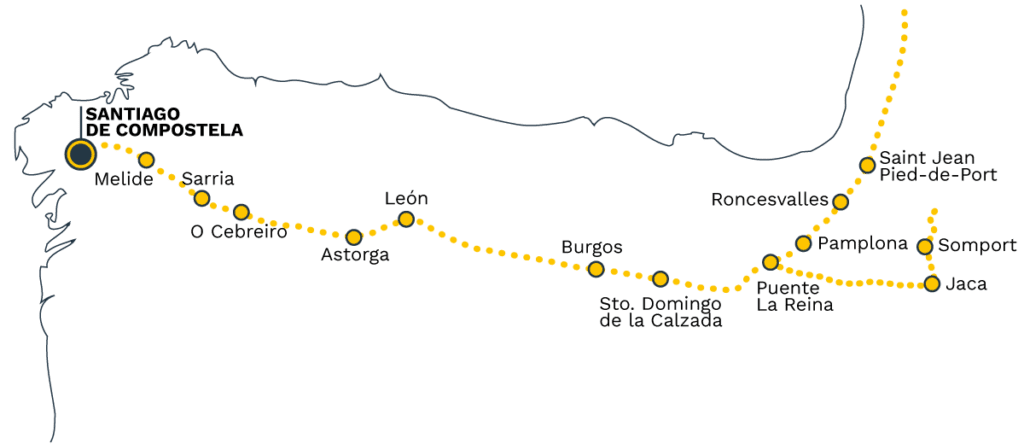French Way
- 768 km from Roncesvalles
- 33 stages on foot
- 14 cycling stages
The French Way is the most popular of the routes that make up the Camino de Santiago. It is also the one with the best infrastructure in terms of accommodation and more help for pilgrims. We welcome you to this ancient route, its spectacular scenic and cultural heritage (with several World Heritage cities), its gastronomy and its stories.


Information about the French Way
Advantages and disadvantages
Where does it start?
Points of interest
The French Way is by far the most famous and busiest of the Camino de Santiago routes. The route par excellence, in fact. The most typical. The one that most people choose to start with. The best signposted. The one with the most and best infrastructures.
We could go on for a long time with phrases beginning with "the most" or "the best". But what does that mean, exactly?
It is also the most crowded route. It is precisely because it is the one with the best facilities and the one that has received the best promotion. But the question is: is this your route? Is this the best Camino for you?
Without a doubt, it can be if you want to meet people and walk the paths that other people like you have walked before, for centuries, and will walk later. The hostels on this route are full of stories to share and great moments in company. And not just the hostels. The other kind of accommodations also receive countless pilgrims who leave their mark.
However, if you are going to do the route from hostel to hostel, bear in mind the following: the places available are limited and in the busiest periods, you will have to get up very early in order to arrive at the next end of the stage with enough time to avoid running out of room.
However, this has an advantage: if you walk later in the day you will have a much clearer route. On such a busy route, a bit of peace and quiet is always appreciated. In order to be able to do this and have your accommodation guaranteed, the best thing to do is to plan everything in advance and look for alternatives to pilgrim hostels.
This avoids the problems of overcrowding and you can dedicate yourself to enjoying the Camino. If you are thinking about this option, we can help you to plan it. But first, it is better that you read on.
To complete the Camino and receive the Compostela, the document that certifies the pilgrimage, you will need to walk the last 100 kilometres - 200 km if you come by bicycle. If you don't have many days, Sarria (113 km) is the perfect starting point. From there you should reach Santiago in five or six days, depending on your pace.
But there are also many people who do it from O Cebreiro (155 km). Or from Saint Jean Pied-de-Port (785 km). Or from somewhere in between, such as Pamplona, Logroño, Burgos, León or Astorga. The choice is yours. Moreover, if you want to do it from Saint Jean or from Roncesvalles, nobody forces you to do it in its entirety. You can spread it over several times.
If you choose to do the Camino by bicycle or on horseback, you will have to start from Ponferrada (209 km) to meet the distance requirement of the Compostela. Although perhaps the most common starting point for this type of pilgrimage is León (311 km).
- The Royal Collegiate Church of Roncesvalles.
- The bridge over the river Arga at Puente La Reina.
- The monastery of Santa María la Real at Nájera.
- Burgos Cathedral.
- The church of Saint Martin at Frómista.
- The cathedral of Saint Mary at León.
- The Episcopal Palace of Astorga.
- The ethnographic site of O Cebreiro.
- The monastery of Samos.
- The church of Saint Nicholas de Portomarín.
- Cathedral of Santiago de Compostela.
In the Pilgrim's Blog you have an article on these and other must-see sights of the French Way.
Or you can also check the agenda of cultural events on the Camino.







